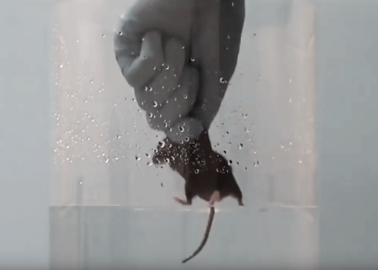How Nanotechnology Can Lead to More Tests on Animals – and What PETA Scientists Are Doing About It
Nanomaterials are used in everyday products like sunscreen and toothpaste. But, as the field grows, regulators are calling for more and more tests on animals. PETA scientists are on a mission to find humane, modern, non-animal solutions.

What Is Nanotechnology?
Nanotechnology is just science, engineering, and technology carried out at the nanoscale, which is one billionth of a metre – more than 500 times thinner than a human hair!
Materials on this scale are called nanomaterials, and although natural ones have been around forever (minerals produced in volcanic ash, for example), research into making them in laboratories has only become popular in the past few decades. By controlling their size and composition, scientists have been able to create nanomaterials with extraordinary properties, so that they can be used to make sports equipment that’s extra-strong but extremely lightweight or to build computers that are very small but very powerful.
How Nanomaterials Lead to More Tests on Animals
Regulatory agencies worldwide are asking for nanomaterials to be tested in a way that could mean significantly more tests on animals than are currently used for regular chemicals. This is because each nanomaterial can take many forms, such as having a different shape or surface coating. For example, nanomaterials are now being tested under the Registration, Evaluation, Authorisation and Restriction of Chemicals (REACH) regulation and, because there are so many different types of nanomaterial, the number of tests which the regulators ask for is expected to be huge.
How PETA Scientists Work to Help Animals
Dr Jodie Melbourne is PETA UK’s nanotechnology specialist. As part of PETA’s science team and the PETA International Science Consortium Ltd., she works to replace tests on animals for nanomaterials. Her work includes:
- Meeting with companies and regulatory bodies to discuss ways to reduce and replace the use of animals in regulatory testing
- Attending conferences to present the results of the non-animal research project being funded by the Consortium, which focuses on the effects of inhaling nanomaterials, aiming to replace archaic methods such as squeezing rats into tubes and forcing them to inhale nanomaterials for up to six hours a day for months on end
- Supporting companies in their appeals against the European Chemicals Agency (ECHA), the body responsible for overseeing REACH, when they’ve been asked by ECHA to conduct tests on animals

What Are the Alternatives to Animal Experiments?
There are lots of animal-free ways to test the effects of substances on humans, and most of the ones that work for chemicals also work for nanomaterials – they may just need some tweaks and a bit of extra thought.
Some of the most innovative techniques use three-dimensional models of human tissues and cells and have the benefit of producing human-relevant information. Scientists have even made organs-on-chips, which allow detailed studies of effects on humans, and micromodels of the human brain. Many of these techniques are now being accepted by regulators. By promoting these non-animal tests, we can help spare tens of thousands of animals a life of suffering.
How You Can Help
For years, PETA has been challenging ECHA to do more to ensure that companies avoid testing on animals when other options are available. Whether it’s meeting with nanomaterial producers to promote non-animal tests or supporting companies in their appeals against ECHA decisions, PETA is standing up for animals. Please take a moment to learn more about REACH and make a much-needed donation to support our innovative, life-saving work for animals.



